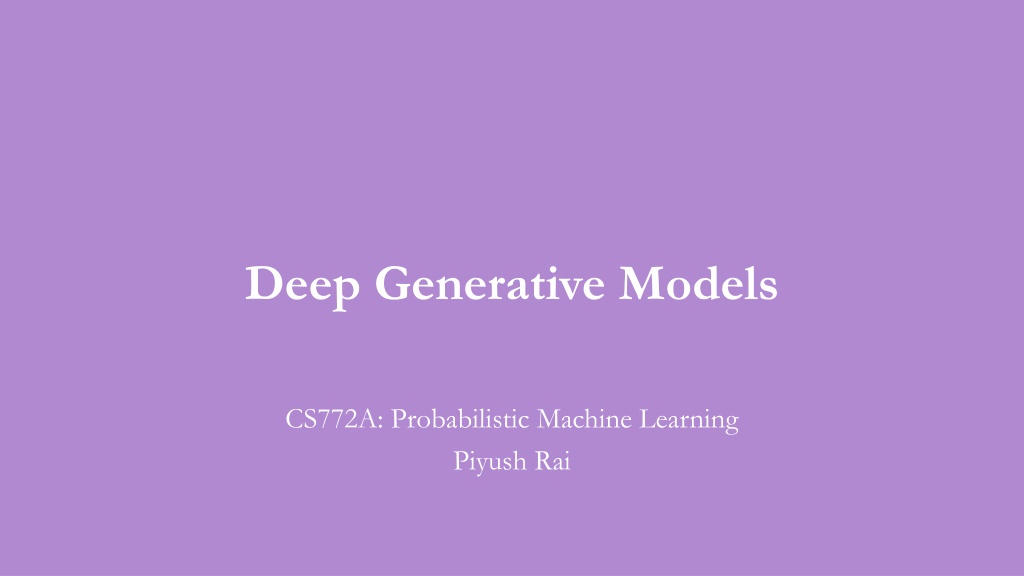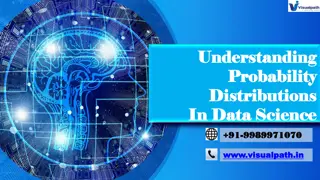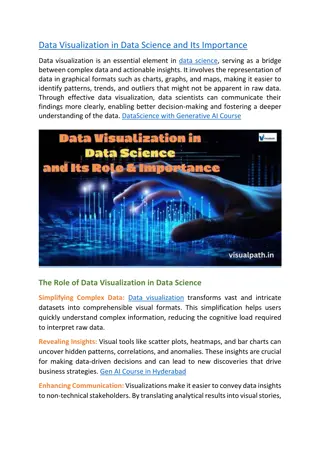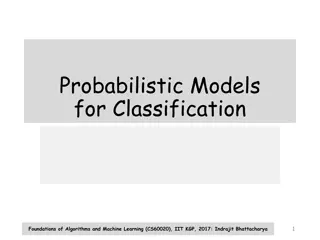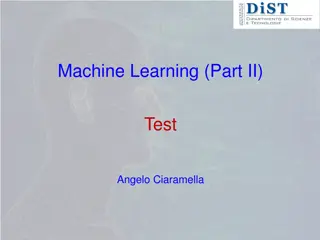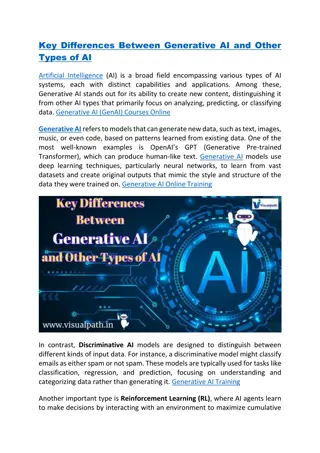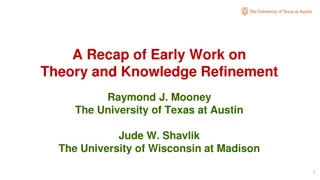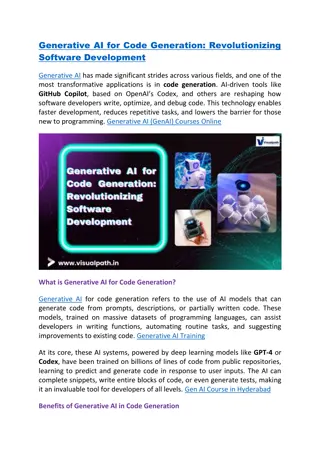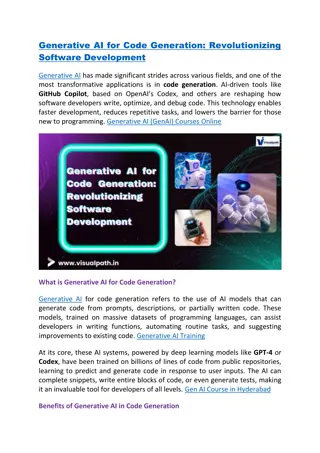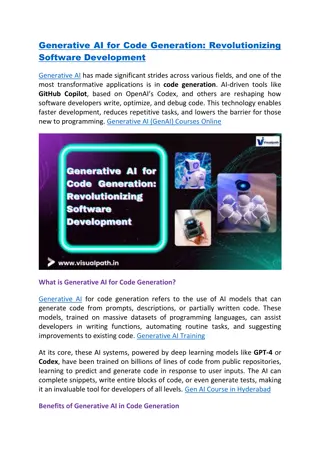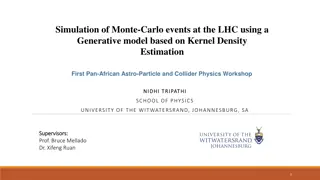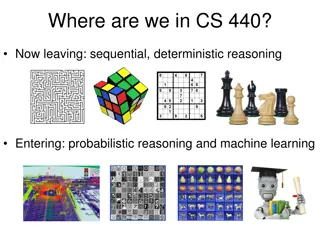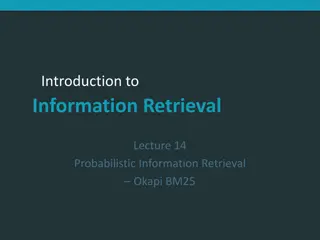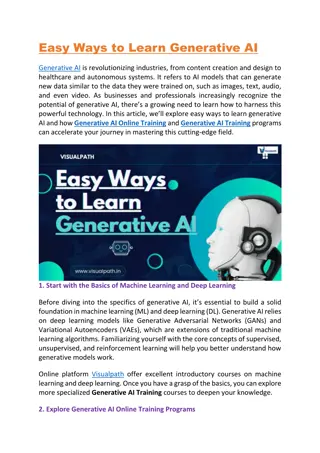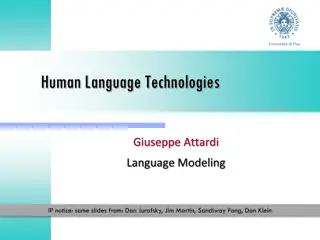Understanding Deep Generative Models in Probabilistic Machine Learning
This content explores various deep generative models such as Variational Autoencoders and Generative Adversarial Networks used in Probabilistic Machine Learning. It discusses the construction of generative models using neural networks and Gaussian processes, with a focus on techniques like VAEs and DLGMs. The concept of Variational Autoencoder (VAE) is explained, emphasizing its components and the reparametrization trick used for optimization. Additionally, it introduces Amortized Inference as a method to speed up posterior inference in latent variable models.
- Deep Generative Models
- Probabilistic Machine Learning
- Variational Autoencoders
- Generative Adversarial Networks
- Neural Networks.
Download Presentation

Please find below an Image/Link to download the presentation.
The content on the website is provided AS IS for your information and personal use only. It may not be sold, licensed, or shared on other websites without obtaining consent from the author. Download presentation by click this link. If you encounter any issues during the download, it is possible that the publisher has removed the file from their server.
E N D
Presentation Transcript
Deep Generative Models CS772A: Probabilistic Machine Learning Piyush Rai
2 Plan Variational Autoencoders Generative Adversarial Networks Denoising Diffusion Models CS772A: PML
3 Constructing Generative Models using Neural Nets We can use a neural net to define the mapping from a ?-dim ?? to ?-dim ?? ?(?|NN ?;? ) ?(?) ?? ?? Another alternative is to use a GP instead of a neural net If ?? has a Gaussian prior, such models are called deep latent Gaussian models (DLGM) Since NN mapping can be very powerful, DLGM can generate very high-quality data Take the trained network, generate a random ? from prior, pass it through the model to generate ? Some sample images generated by Vector Quantized Variational Auto-Encoder (VQ-VAE), a state-of-the-art DLGM CS772A: PML
4 Variational Autoencoder (VAE) VAE* is a probabilistic extension of autoencoders (AE) The basic difference is that VAE assumes a prior ?(?) on the latent code ? This enables it to not just compress the data but also generate synthetic data How: Sample ? from a prior and pass it through the decoder Thus VAE can learn good latent representation + generate novel synthetic data The name has Variational in it since it is learned using VI principles CS772A: PML *Autoencoding Variational Bayes (Kingma and Welling, 2013) Pic source: https://lilianweng.github.io/lil-log/2018/08/12/from-autoencoder-to-beta-vae.html
5 Variational Autoencoder (VAE) VAE has three main components A prior ??? over latent codes A probabilistic decoder/generator ??(?|?), modeled by a deep neural net A posterior or probabilistic encoder ??? ?approx. by an inference network ??? ? Using the idea of Amortized Inference (next slide) Here? collectively denotes all the parameters of the prior and likelihood Here? collectively denotes all the parameters that define the inference network VAE is learned by maximizing the ELBO ELBO for a single data point Maximized to find the optimal ? and ? ?? should be such that data ? is reconstruct well from ?(high log-lik) ?? should also be simple (close to the prior) The Reparametrization Trick is commonly used to optimize the ELBO Posterior is inferred only over z, and usually only point estimate on ? and ? CS772A: PML
6 Amortized Inference Latent variable models need to infer the posterior ?(??|??) for each observation ?? This can be slow if we have lots of observations because 1. We need to iterate over each ?(??|??) 2. Learning the global parameters needs wait for step 1 to finish for all observations One way to address this is via Stochastic VI Amortized inference is another appealing alternative (used in VAE and other LVMs too) If? is Gaussian then the NN will output a mean and a variance ? ???? ? ???? = ? ??NN(??;?)) Thus no need to learn ?? s (one per data point) but just a single NN with params ? This will be our encoder network for learning ?? Also very efficient to get ? ? ? for a new data point ? CS772A: PML
7 Variational Autoencoder: The Complete Pipeline Both probabilistic encoder and decoder learned jointly by maximizing the ELBO CS772A: PML Pic source: https://lilianweng.github.io/lil-log/2018/08/12/from-autoencoder-to-beta-vae.html
8 Decoder is a neural net and can be arbitrarily powerful making this term very large VAE and Posterior Collapse Consequently, KL will become close to zero collapsing posterior to the prior VAEs may suffer from posterior collapse Thus, due to posterior collapse, reconstruction will still be good but the code ? may be garbage (not useful as a representation for ?) Several ways to prevent posterior collapse, e.g., Use KL annealing A carefully tuned value between 0 and 1 For example, keep the variance of ? as fixed Avoid KL from becoming 0 using some ?doesn t collapse to the prior More tightly couple ? with ? using skip-connections (Skip-VAE) Besides these, MCMC (sometimes used for inference in VAE), or improved VI techniques can also help in preventing posterior collapse in VAEs ?? ?? CS772A: PML Hidden layers of NN
9 VAE: Some Comments One of the state-of-the-art latent variable models Useful for both generation as well as representation learning Many improvements and extensions, e.g., For text data and sequences (VAE for topic models or neural topic models ) Document (e.g., as a vector of word counts) VAE-style models with more than one layer of latent variables (Sigmoid Belief Networks, hierarchical VAE, Ladder VAE, Deep Exponential Families, etc) CS772A: PML Decoupling Sparsity and Smoothness in the Dirichlet Variational Autoencoder Topic Model (Burkhardt and Kramer, 2020)
10 Generative Adversarial Network (GAN) Unlike VAE, no explicit parametric likelihood model ?(?|?) GAN is an implicit generative latent variable model Can generate from it but can t compute ?(?) - the model doesn t define it explicitly GAN is training using an adversarial way (Goodfellow et al, 2013) Thus can t train using methods that require likelihood (MLE, VI, etc) The discriminator can be a binary classifier or any method that can compare b/w two distributions (real and fake here) Assuming data is images Discriminator network is trained to make ?(?) close to 1 Discriminator network is trained to make ? ? ? close to 0 and generator network is trained to make it to be close to 1 to fool the discriminator into believing that ?(?) is a real sample Min-max optimization CS772A: PML
11 Generative Adversarial Network (GAN) The GAN training criterion was With ? fixed, the optimal ? (exercise) Distribution of real data ?????(?) ?????? + ??(?) ? = ?? Distribution of synthetic data Given the optimal ?, The optimal generator ? is found by minimizing ??(?) ?????(?) ?????? + ??(?) ?????? + ??(?) 2 ,? = ?? ?????log ? ?? + ?? ??log ?????? + ??(?) ?????? + ??(?) 2 Jensen-Shannon divergence between ????? and ??. Minimized when ??= ????? = KL ?????? + KL ??? log 4 Thus GAN can learn the true data distribution if the generator and discriminator have enough modeling power CS772A: PML
12 GAN Optimization The GAN training procedure can be summarized as ?? and ?? denote the params of the deep neural nets defining the generator and discriminator, respectively In practice, for stable training, we run ? > 1 steps of optimizing w.r.t. ? and 1 step of optimizing w.r.t. ? Reason: Generator is bad initially so discriminator will always predict correctly initially and log(1 ?(? ? ) will saturate In practice, in this step, instead of minimizing log(1 ?(? ? ), we maximize log ? ? ? CS772A: PML
13 GANs that also learn latent representations The standard GAN can only generate data. Can t learn the latent ? from ? Bidirectional GAN* (BiGAN) is a GAN variant that allows this Consists of an encoder as well Real pair/fake pair? Can be shown* to invert ? Adversarially Learned Inference# (ALI) is another variant that can learn representations Encoder with joint ? ?,? = ? ? ?(?|?) Decoder/generator with joint ? ?,? = ? ? ?(?|?) Discriminator: Real pair or fake pair? CS772A: PML *Adversarial Feature Learning (Donahue et a Dumoulin l, 2017) #Adversarially Learned Inference (Dumoulin et al, 2017)
14 Evaluating GANs High IS and low FID is desirable Two measures that are commonly used to evaluate GANs Inception score (IS): Evaluates the distribution of generated data Frechet inception distance (FID): Compared the distribution of real data and generated data Both IS and FID measure how realistic the generated data is Inception Score defined as exp(?? ??[KL(?(?|?)| ? ? ]) will be high if Very few high-probability classes in each sample ?: Low entropy for ? ? ? We have diverse classes across samples: Marginal ?(?) is close to uniform (high entropy) FID uses extracted features (using a deep neural net) of real and generated data Usually from the layers closer to the output layer These features are used to estimate two Gaussian distributions ?(??, R) ?(??, G) Using real data Using generated data 2+ trace( ?+ ? ? ? 1/2) FID is then defined as FID = ?? ?? CS772A: PML
15 GAN: Some Issues/Comments GAN training can be hard and the basic GAN suffers from several issues Instability of training procedure Mode Collapse problem: Lack of diversity in generated samples Generator may find some data that can easily fool the discriminator It will stuck at that mode of the data distribution and keep generating data like that GAN 1: No mode collapse (all 10 modes captured in generation) GAN 2: Mode collapse (stuck on one of the modes) Some work on addressing these issues (e.g., Wasserstein GAN, Least Squares GAN, etc) CS772A: PML
16 After learning the model, can use the reverse process to generate data from random noise Denoising Diffusion Models Based on a forward (adding noise) process and a reverse (denoising) process Steps of the forward process are defined by a fixed Gaussian ?(??|?? 1) The f.p. starts with the clean image ?0 and adds zero-mean Gaussian noise at each step The f.p. distribution is defined as ? ???? 1 = ?(??| Eventually as ? , we get ?? which is isotropic Gaussian noise Can show: ? ???0 = ?(??| ???0,(1 ??)?) where ??= 1 ?? and ??= ?=1 Steps of the reverse process are defined by a learnable Gaussian ??(?? 1|??) ??(?? 1|??) is an approximation of the reverse diffusion ? ?? 1?? ??(?? 1|??) modeled as ?(?? 1|????, ???) where ?? and ? are neural nets ?? (0,1) 1 ???? 1,???) ? ?? CS772A: PML
17 Denoising Diffusion Models: Training Upper bound on the negative log-likelihood (negative of the ELBO) The model is trained by minimizing the following objective ???0:? ? ?1:??0 ? log ???0 ? log = ?0+ ?1+ ?2+ + ?? 1+ ?? Overall loss is just a sum of several KL divergences between Gaussians, and thus available in closed form This is also a Gaussian In some ways, denoising diffusion models are similar to VAEs CS772A: PML
18 Summary Looked at various methods for generative modeling for unsupervised learning Classical methods (FA, PPCA, other latent factor models, topic models, etc) Deep generative models (VAE, GAN, Denoising Diffusion Models) Many of these methods can also be extended to model data other than images There are also generative models that do not use latent variables Can still be used to generate data and learn the underlying data distribution Assuming each observation is n-dimensional An auto-regressive model Can use a neural network to learn (parameters of) each of these distributions An example: Neural Autoregressive Density Estimator (NADE) CS772A: PML
